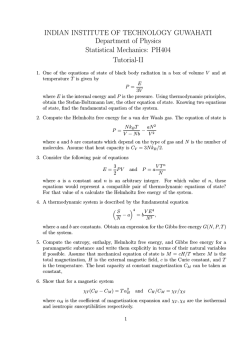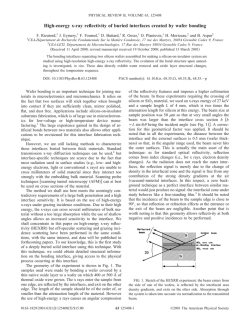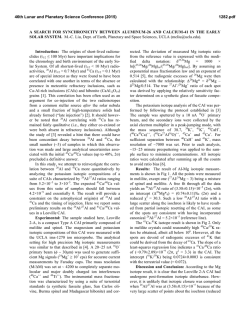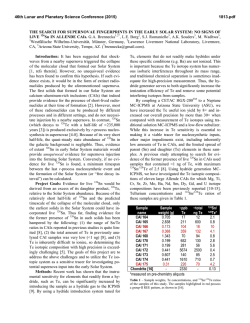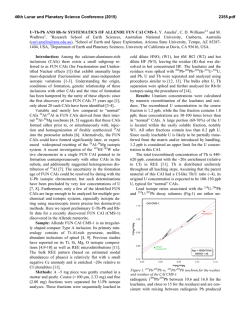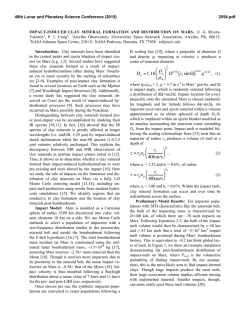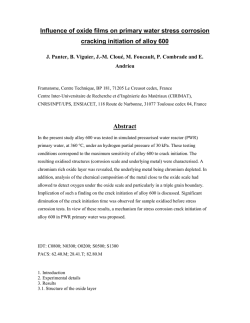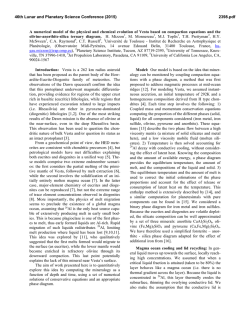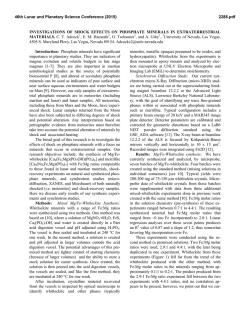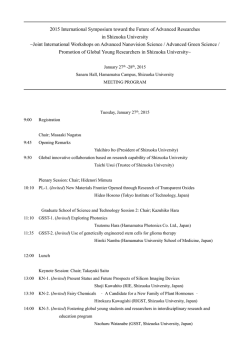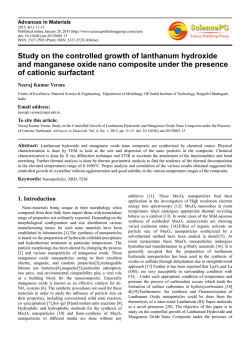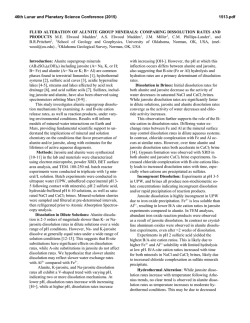
High-Temperature Thermodynamic Properties of CAI Minerals
46th Lunar and Planetary Science Conference (2015) 1270.pdf HIGH-TEMPERATURE THERMODYNAMIC PROPERTIES OF CAI MINERALS. S. I. Shornikov and O. I. Yakovlev, Vernadsky Institute of Geochemistry & Analytical Chemistry of RAS, Kosygin st., 19, Moscow, 119991, Russia; e-mail: [email protected]. The physico-chemical modelling of the evaporation and condensation processes is the actual task in meteorite genesis studies. The refractory substances of Ca– Al–inclusions (CAI) are caused a special interest. They are met in chondrites and are the earliest object of the solar system with unusual isotope characteristics [1]. The CAI basic forms the next oxide minerals: calcium aluminate (CA), grossite (CA2), hibonite (CA6), perovskite (CT), magnesium spinel (MA), enstatite (MS), forsterite (M2S), diopside (CMS2), akermanite (C2MS2), gehlenite (C2AS), anorthite (CAS2) and grossular (C3AS3). Thus, the CAI thermodynamic properties may be described in frames of CMATS system (CaO–MgO–Al2O3–TiO2–SiO2). The CAI modern genetic models are based on experimental results of the multicomponent oxide system evaporation studies at conditions of vacuum and high temperatures. The oxide activity value in the system (ai) is the important parameter, determined their partial pressure according to the equation: ai = pi / p°i, (1) where pi and pi° – the oxide partial pressure over the multicomponent system and individual oxide, correspondingly. At the present time the most reliable experimental approach to obtain such information is the Knudsen effusion mass spectrometric method [2]. In turn, this method allows to check also a correctness of various theoretical approaches which possible to calculate of oxide activity values in the multicomponent system in a considerable interval of temperatures and concentrations. Two models apply most widely for the theoretical description of these processes – MELTS and CMAS. The MELTS [3] is intended for calculation of silicate melt thermodynamic properties. However the model doesn't describe CAI and low-ferriferous chondrules [4]. The CMAS [5] is intended for CaO–MgO–Al2O3– SiO2 system and can be used only for calculation of melt thermodynamic properties within fourfold system, but it isn't applicable for calculation of properties in whole concentration interval from CAI to chondrites [6]. The thermodynamic models in frames of ideal associated solution theory (IAST) [7] are more preferable in this connection. In comparison with the mentioned model, IAST models allow to calculate more exactly the melt thermodynamic properties and the melt chemical evolution at evaporation. Their advantage consists that determination of component activities in the multicomponent oxide melt is based on direct experimental measurements whereas in the MELTS and CMAS of component activity in melt obtain by indirect way. The IAST models suggest the similarity of liquid and crystal properties and consider the solution as ideal mixture of monomeric molecules and associative complexes at all concentrations. Observed experimentally considerable deviations from ideality are explained by the interactions leading to the associated complex formation in solution. In this case interactions between the different types of molecules leading to association aren't considered as the formed association, by definition, we can consider as a complex and the system “monomer – complex” is approximately ideal. The standard Gibbs energies of formation (ΔG°) of the condensed phases entering into the considered multicomponent system formed of any number of components are used as the model parameters. The total energy of system accepts the minimum value in the case of equilibrium conditions that is equivalent to the solution of equation system of the component mass balance and the mass action law for all reactions in system at given concentration. It necessary to note that models don't contain empirical parameters and describes all thermodynamic properties of multicomponent systems at any temperature. The calculation accuracy of oxide activities in multicomponent system substantially depends on the set reference values of ΔG° of the condensed phases which often haven’t the demanded accuracy especially at high temperature; it is easy to be convinced comparing the thermodynamic values accepted in various reference data base [8–10]. The aim of the present study is consideration of the available direct experimental thermodynamic information on standard Gibbs energies of formation of the listed minerals containing in CAI. The special attention was paid to the high-temperature thermodynamic data (higher than 1000 K) obtained by mass-spectrometric Knudsen effusion method [11–17] for a reasonable choice of the values demanded for calculations of oxide activities in multicomponent system. On the base of experimental data on hightemperature properties of CAI minerals the data listed in Table 1 were recommended for the oxide activity calculations in the CMATS system. The enthalpy (HT) and entropy (ST) of formation of mineral in the crystalline state were calculated using the Gibbs energy 46th Lunar and Planetary Science Conference (2015) of mineral ΔGT in the assumption of their constancy in a limited temperature interval on the equation: ΔGT = ΔHT – T ΔST, (2) where ΔGT was calculated using the oxide activities and mole fractions (xi) according to the equation: ΔGT = RT Ʃxi lnai, (3) which are connected with the standard Gibbs energies of mineral formation on the equation: ΔG° = Ʃni ΔG°i + ΔGT Ʃni, (4) where ΔG°i – the standard Gibbs energy of i-th oxide formation and ni – the oxide mole numbers in mineral. It is possible to notice that perovskite and gehlenite possess the smallest values of GT, hibonite and enstatite has the greatest values of GT (Fig. 1). We can see that GT for all minerals in crystalline state in the considered temperature range change slightly that explaine their small values of ST (Table 1). However in the liquid state GT sharply go down with the temperature growth for all minerals. The correctness of the recommended thermodynamic data was confirmed by the IAST model calculations of oxide activities in the binary and ternary systems which are a part of the CMATS system, and also the results of calculations of the multicomponent melt concentration evolution coinciding with experimental data [18]. References: [1] Grossman L. et al. (2008) Geochim. Cosmochim. Acta, 72, 3001–3021. [2] Sidorov L. N. (1992) Int. J. Mass Spectr. Ion Proc., 118, 739–754. [3] Ghiorso M. S. and Sack R. O. (1995) Contrib. Miner. Petrol. 119, 197–212. [4] Alexander C. M. O 'D. (2002) Met. Planet. Sci., 37, 245–256. [5] Berman R. G. (1983) A thermodynamic model for multicomponent melts, with application to the system CaO–MgO– Al2O3–SiO2, 153 pp. [6] Davis A. M. and Richter F. M. (2003) Theatise on geochemistry, 407–430. [7] Prigogine I. and Defay R. (1954) Chemical thermodynamics, 543 pp. [8] Barin I. (1995) Thermochemical data of pure substances, 2002 pp. [9] Robie R. A. and Hemingway B. S. (1995) U. S. Geol. Surv. Bull., 2131, 461 pp. [10] Chase M. W. (1998) NIST–JANAF themochemical tables, 1951 pp. [11] Shornikov S. I. et al. (1997) Russ. J. Phys. Chem., 71, 23–27. [12] Shornikov S. I. (2013) Modern problems of theoretical, experimental and applied mineralogy (Yushkin Memorial Seminar), 367–368 (in Russian). [13] Shornikov S. I. (2002) Herald Earth Sci. Dept. RAS, 20, 1–2. [14] Kambayashi S. and Kato E. (1984) J. Chem. Thermodyn., 16, 241–248. [15] Shornikov S. I. et al. (1997) Russ. J. Phys. Chem., 71, 174–178. [16] Morita K. et al. (2002) Scand. J. Met., 31, 178– 183. [17] Stolyarova V. L. et al. (1996) High Temp. Mater. Sci., 36, 15–35. [18] Markova O. M. et al. (1986) Geokhimiya, 11, 1559–1569. 1270.pdf Table 1. High-temperature thermodynamic properties of CAI minerals [11–17]. CA CA2 CA6 HT, kJ/mole –8.91 –6.34 –2.88 CT MA MS –39.51 –13.29 –10.28 2.87 4.38 –0.07 M2S CMS2 C2MS2 C2AS CAS2 C3AS3 –21.76 –36.55 –36.43 –37.33 –26.70 –47.70 –0.92 –3.15 –2.41 2.11 –1.10 –10.98 Mineral ST, J/(mole·K) 11.10 9.94 5.00 Tmelt, K 1877 2035 2123* 2148** 2243 2408 1836* 1850** 2171 1665 1727 1863 1830 1373* 1673** Hmelt, kJ/mole 31.90 27.00 16.80 96.68 100.30 25.93 38.00 34.43 24.78 43.03 33.30 71.00 * the dissociation temperature; ** the liquid phase temperature. Figure 1. The temperature dependences of CAI mineral’s Gibbs energies: 1 – calcium aluminate, 2 – grossite, 3 – hibonite, 4 – perovskite, 5 – magnesium spinel, 6 – enstatite, 7 – forsterite, 8 – diopside, 9 – akermanite, 10 – gehlenite, 11 – anorthite and 12 – grossular.
© Copyright 2025
